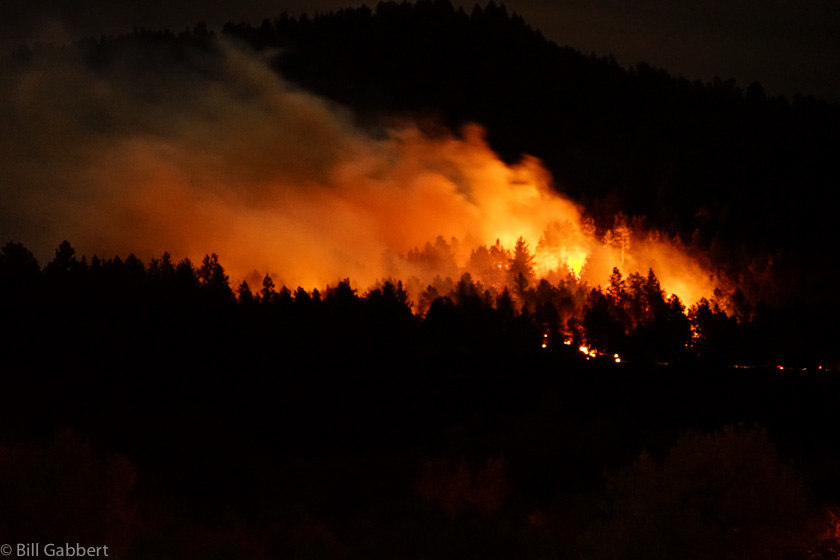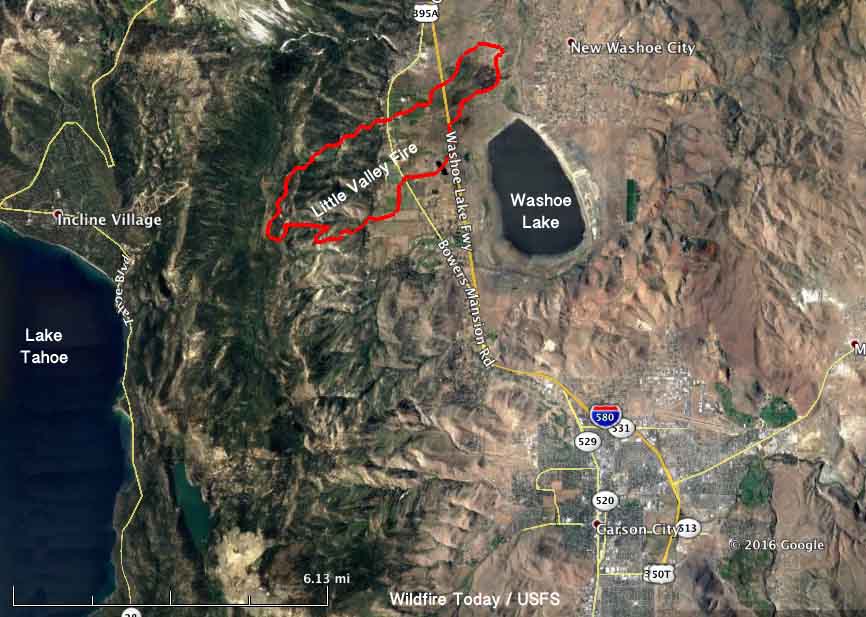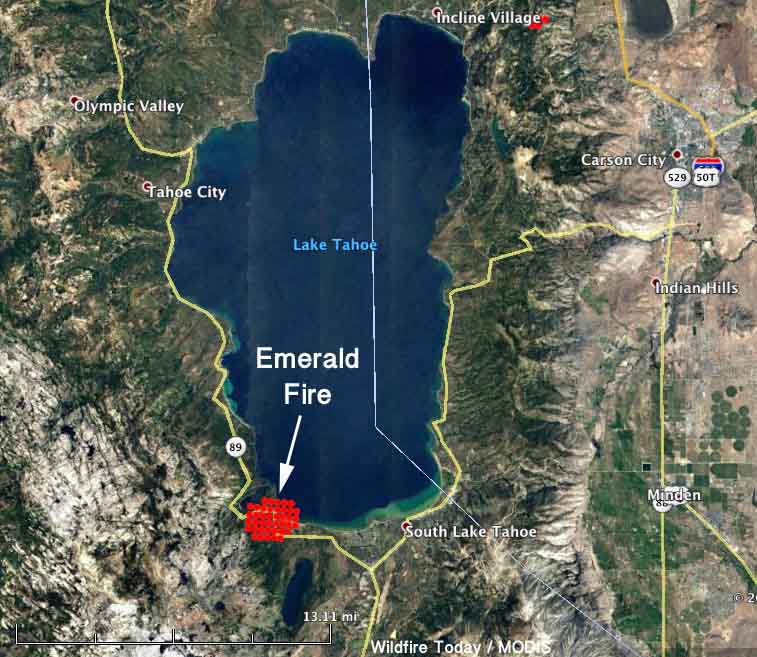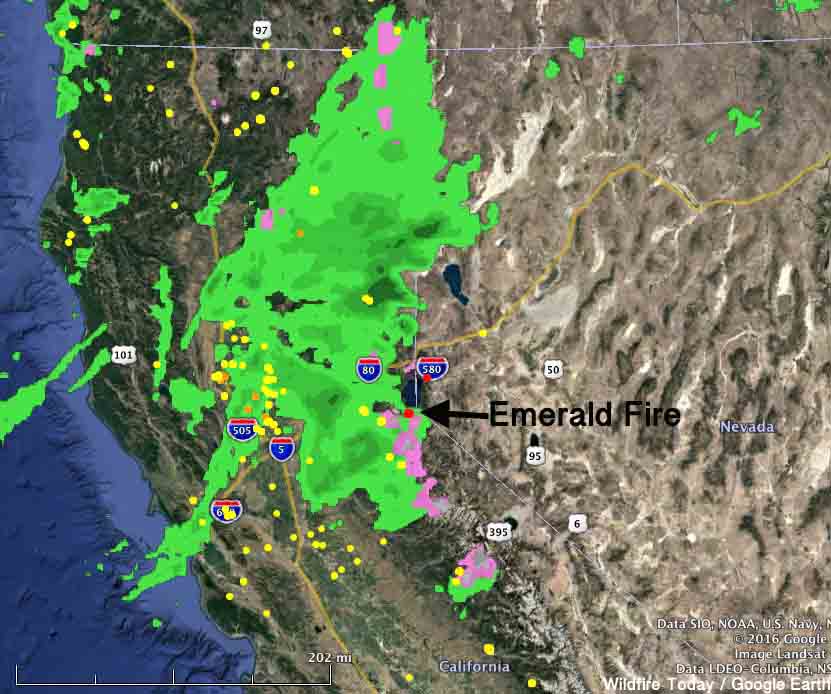There's nothing cool about cancer. Clean it!@paulcombsart #drawnbyfire @fireengineering pic.twitter.com/S92z9d1Qc1
— Paul Combs (@paulcombsart) October 13, 2016
Category: Uncategorized
South Dakota: Battle Fire east of Hot Springs
Above: Battle Fire at 9:40 a.m. MDT October 15, 2016. Photo by Bill Gabbert.
(UPDATED at 2:56 p.m. MDT October 15, 2016)
In the above photo we took Saturday morning the Battle Fire east of Hot Springs, South Dakota looks more benign than it did Friday night. Authorities are reporting it has burned 22 acres.
Fall River County Emergency Manager Frank Maynard said the fire was contained at 2 a.m. Saturday. It will continue to produce smoke for several days as the interior fuels smoulder.
****
(UPDATED at 12:12 a.m. MDT October 15, 2016)
The Battle Fire east of Hot Springs, South Dakota continues to spread. At about 11:30 p.m. the size was estimated at 10 acres, but since then has grown slowly to the south and southeast. Firefighters are using a South Dakota state dozer to construct fireline in addition to the crews from a number of engines. At midnight it was surprisingly warm and dry for mid-October. The temperature at the fire was 72 and the relative humidity was 26 percent.
****
(UPDATED at 10:17 p.m. MDT October 14, 2016)
At about 8 PM on Friday the Battle Fire broke out east of Hot Springs, South Dakota at the base of Battle Mountain. Firefighters were worried about it spreading to the top of Battle Mountain and endangering electronic sites. By about 9:25 p.m. after it had burned 5 acres the spread had been slowed. But the wind continued to cause spot fires out ahead of the main fire, challenging firefighters.
The fire started under a nearly full moon on the boundary of the Veterans Administration Hospital property east of the facility. Their fire department notified the Hot Springs FD and requested assistance.
A dozer was ordered to help improve a poorly maintained road in order to provide better access for fire engines.
The weather forecast for the fire area predicts 7 mph winds out of the northwest Friday night, slowing to 3 mph at 6 a.m. The maximum relative humidity will be 61 percent at 6 a.m.
For Saturday the National Weather Service expects 73 degrees, 24 percent relative humidity, and 10 to 12 mph west winds gusting to 16 after noon. These conditions could be conducive to continued fire spread.

Little Valley Fire burns structures northwest of Carson City, NV
In the hours before the fire was reported, wind gusting at 87 mph was recorded at a nearby weather station.
(UPDATED at 11:35 p.m. PDT October 14, 2016)
At 9:30 p.m. Washoe County updated the number of structures burned — 22 homes and 17 outbuildings. The fire has blackened 3,455 acres.

****
(UPDATED at 3:24 p.m. PDT October 14, 2016)
Washoe County reported at 2:45 p.m. Friday about the Little Valley Fire:
Everyone who lives on the east side of Washoe Lake or the east side of I-580 can return home.
Evacuations for residents of the Galena, Montreaux, Joy Lake Rorad, and St. James neighborhoods can return home but need to be prepared to evacuate throughout the weekend if need be.
The west side of Washoe Lake from Bowers exit to the bottom of Franktown Rd. remains evacuated. Several local hotels are offering discounted room rates for those displaced by Friday’s fires.
A weather station near the fire recorded 0.10 of rain after 11 a.m. today. The relative humidity has increased to 83 percent but the wind is still strong, 14 mph gusting to 34 mph. Radar showed light rain in the area at 3:24 p.m. on Friday.
@TMFPD is the Twitter account for the Truckee Meadows Fire Protection District.
#LittleValleyFire update: Fire district got call 1:38 a.m. about glow on hill at site of controlled burn earlier this week. #wildfire
— Jason Hidalgo (@jasonhidalgo) October 14, 2016
“Our crew responded and found about 5 acres on fire at the controlled burn site,” said @TMFPD chief Charles Moore. #LittleValleyFire
— Jason Hidalgo (@jasonhidalgo) October 14, 2016
****
(Originally published at 1:16 p.m. PDT October 14, 2016)
Dozens of structures have burned in the Little Valley Fire 6 miles northwest of Carson City, Nevada and 17 miles south of Reno. It was reported at 2 a.m. PDT on Friday, Oct, 16, 2016. At 12:15 p.m. Washoe County reported that firefighters are estimating 2,000 acres, 18 homes, seven outbuildings, and seven barns have burned in the fire west of Washoe Lake.
Authorities have not released a cause for the fire but the Reno Gazette-Journal raised the possibility that it might have been associated with a prescribed fire:
As part of the investigation on the cause of the fire, the forestry division will look into any potential links from a prescribed burn that was held prior to the fire, said Jenny Ramella, Nevada Forestry Division spokeswoman. Ramella stressed that the cause of the fire has yet to be determined.
We don’t yet have a good map showing the exact location of the wildfire, but the Nevada Division of Forestry covered on their Facebook page the progress of the “Little Valley Burn”, a prescribed fire, that was ignited between October 4 and 7. On October 12 the NDF reported they had completed 208 acres. The location appears to have been west of where the wildfire is burning now.
Continue reading “Little Valley Fire burns structures northwest of Carson City, NV”
200-acre Emerald Fire at Lake Tahoe slowed by rain

The Emerald Fire was reported at 1:28 a.m. PDT October 14 on the south end of Lake Tahoe in California near Emerald Bay. Pushed by 20 to 25 mph winds gusting up to 55 mph it quickly spread through the night and by daylight was estimated at 200 acres by CAL FIRE. Mandatory evacuations were ordered affecting 500 residences and another 500 were listed as voluntary.
However by 6 a.m. on Friday light rain began as a wet air mass moved into the area. As of 11 a.m. a quarter inch of precipitation had been measured at the South Lake Tahoe weather station.

The weather forecast for the area of the Emerald Fire includes 1.8 inches of precipitation over the next 48 hours.
Web cams for the area can be seen at Alerttahoe.seismo.unr.edu. Click on the Diamond Peak and Heavenly Ski Area cams.

Red Flag Warnings, October 14, 2016
The National Weather Service has posted Red Flag Warnings or Fire Weather Watches for areas in California, Nevada, Wyoming, Nebraska, South Dakota, and Colorado. The Warnings end Friday evening, while the Watch in Colorado expires Saturday at 7 p.m. MDT.
The Red Flag map was current as of 9:30 a.m. MDT on Friday. Red Flag Warnings can change throughout the day as the National Weather Service offices around the country update and revise their forecasts and maps.
The graphic below was issued by the NWS office in Rapid City, South Dakota. This forecast for Friday covers western South Dakota and portions of North Dakota, Montana, Wyoming, and Nebraska.
Two firefighter injuries, a snakebite and gasoline fire
Reports about two notable injuries to wildland firefighters have been released in recent days.
A “72-hour” report provides very little information about another in a series of accidents that may involve a “gasoline geyser”. The document does not include the date of the injury, the location of the accident, or the name of the fire or incident, but it was issued by the Arapaho and Roosevelt National Forest and Pawnee National Grassland headquartered in Fort Collins, Colorado. It is titled “Pingree Hill Chainsaw Incident” and says a firefighter that was working on a prescribed fire sustained gasoline fire burns to the abdomen, arm, and wrist related to a chainsaw while working on a prescribed fire. He was flown to the Northern Colorado Burn Center where he is recovering.
Since at least September 30, 2016 Inciweb has had information about a 2,027-acre “Pingree Hill Prescribed Fire” near Rustic, Colorado that apparently is being conducted on an intermittent basis.
Many injuries have been reported in the last couple of years related to gasoline being forcefully released from chain saws. Some of these incidents have occurred with saws that have the new quarter-turn gas caps.
Here is a video released a year ago on the subject:
The second injury is titled “Rattlesnake Bite” in the Rapid Lesson Sharing report that was released by the Wildland Fire Lessons Learned Center. It happened on the Kent Fire in Montana July 24, 2016. The firefighter never saw or heard the snake that bit him, the report says.
Below are excerpts from the report:
A team of more than five EMTs were assigned to patient care, with one EMT identified as lead caregiver.
[…]
Disagreement Involving Interventions and Patient Care
Once the ambulance arrived on scene, there was a disagreement between the ambulance personnel and onsite EMTs involving interventions and patient care being provided. Because of the dispute and increased level of pain experienced by the patient, Division Whiskey decided to transport the patient via the DNRC [Montana Department of Natural Resources and Conservation] helicopter.
The lead caregiver and one other DNRC EMT joined the patient in transit to Baker. The DNRC Task Force Leader followed via ground transport in order to bring the EMTs back once patient care had been transferred.
Upon arrival at the Baker Municipal Airport, the patient was transported to the Fallon Medical Complex emergency room. Medical personnel assessed the bite and cleaned wound.
Because it was determined that side-effects could have adverse effects on this patient, it was decided to hold off on administering antivenin, a biological product used in the treatment of venomous bites and stings. After tissue samples were taken and sent to the lab, it was determined that the bite was nonvenomous.
The patient was monitored and released that evening.




